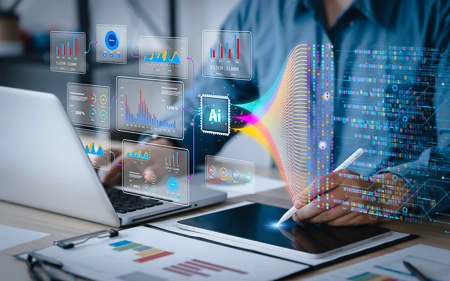Evolution of Safety Management Software: From Paper to AI-Driven Safety
The Future of Workplace Safety with AI
Today, the market is saturated with numerous safety management software solutions, all vying for the same clientele.
Each boasts a portfolio of major clients who either currently use or, more accurately, have used their products at some point.
The sales pitch follows a familiar pattern: (i) this is what our software does, (ii) these are the companies that use it, and (iii) book a demo today.
Despite their branding differences, most of these platforms rely on the same fundamental technology—a user-friendly interface, a cloud-based backend, and various integration layers to connect with widely used enterprise software.
At their core, these systems primarily serve to digitise existing paper-based safety management processes rather than offering transformative advancements in safety management itself.
The vast majority of solutions available today fall into the category of Generation II Safety Management Software (Gen II-SMS)—focused on digital record-keeping rather than reimagining how safety is managed.
GenI-SMS: Spreadsheet-Based Systems (Circa 2000)
The earliest safety management software solutions were little more than glorified spreadsheets. In fact, some were exactly that—fancy spreadsheet that might appear sophisticated to the average user but would be easily recognisable to experienced Excel users.
These GenI-SMS were largely developed in-house by safety departments, using spreadsheet templates sourced online or shared among industry professionals.
Their effectiveness was as limited as their scope. The more advanced versions included worksheets for tracking accidents, training, observations, and other key safety metrics. Some even featured a hyperlink worksheet that provided quick access to standard operating procedures, risk assessments, and other frequently referenced documents. Others integrated other tools such as Sharepoint lists, MS Access Databases, and PBI
Given this foundation, it's no surprise that many Generation II Safety Management Software (Gen II-SMS) platforms started as online adaptations of these early spreadsheet-driven systems.
GenII-SMS: Cloud-Driven Modular Systems (2010–2025)
By the 2010s, cloud computing had become mainstream, transforming various aspects of business operations. While its adoption in safety software lagged behind, the shift was inevitable.
Cloud technology enabled centralised document storage, significantly reducing paper usage. The simultaneous rise of mobile computing created the perfect environment for safety software to evolve.
The early pioneers of Gen II-SMS had a straightforward mission—migrate locally stored safety documents to the cloud and enable seamless remote access, including via mobile devices. With this advancement, site teams could now access layout drawings directly from their phones, and Material Safety Data Sheets (MSDS) became instantly retrievable on-site.
The next wave of GenII-SMS saw the introduction of modular systems for core safety management functions— Incident Management, Training Management, Chemical Management, Audit Management, and more.
These modules provided user-friendly forms that fed data into cloud-hosted databases. Entries triggered automated workflows, notifying relevant stakeholders and dutyholders as per the system’s configuration.
With the influx of large datasets, spreadsheet-based reporting became impractical. Data visualisation tools like Tableau, Power BI, and similar analytics platforms replaced Excel charts as the preferred reporting mechanism.
As the safety software market grew, new players entered with larger development teams and investor backing, offering advanced tools with high levels of customisation.
The next evolution saw systems providing no-code workflow builders, allowing users to create custom workflows and modules without extensive programming expertise.

Unlike GenI-SMS, which were primarily in-house systems managed by safety teams and IT specialists, GenII-SMS were almost exclusively external cloud-based solutions from external vendors.
While GenII-SMS significantly improved how users interacted with safety management systems, they did not fundamentally change the way safety was managed. Few peer-reviewed studies support marketing claims of improved safety outcomes. Instead, most improvements are based on self-reported user experiences, which, while valuable, lack empirical validation.
Compared to other business functions—such as accounting, logistics, and scheduling—safety management has seen less transformation despite benefiting from the same technological advancements.
With the emergence of mainstream Artificial Intelligence (AI) in the early 2020s, excitement grew around its potential impact on safety management. While vendors in the safety software market have been more measured in their AI claims than those in other industries, AI-driven innovations in safety management are expected to emerge in phases.
GenIII-SMS: AI-Enabled Software Development (2025–2035)
The first wave of AI integration into safety management software will arrive in the form of AI-enabled software development. This is in line with the trend expected across other areas of software development. The main driver of Gen III-SMS will be LLMs.
The fact that Large Language Models (LLMs) like ChatGPT and DeepSeek are the first mainstream application of AI technology means that these systems will lead AI's foray into the software development market.
LLMs understand natural human language and have been shown to be adept at almost all coding languages. The real value of this reality is that solo developers or smaller teams of developers can achieve significantly more in significantly less time using LLMs.
The vendor landscape for safety management software is therefore likely to be disrupted from late 2025. New smaller teams will enter the market with solutions that are just as effective as those from larger vendors.
Solutions such as SET from SafetyRatios is one of the first examples of GenIII-SMS, built by a small team of safety practitioners with extensive field expertise in safety, leveraging emergent LLM support systems.

Of the existing larger vendors, only the most adaptable will thrive in this disruptive market. There will be consolidation of existing teams by larger vendors and the entry of newer teams. So, the trend will be both consolidatory in parts and expansionary in other parts.
Away from LLMs, other aspects of AI will also experience accelerated change and advances. This is because as the power requirement for LLMs grows, the capability of chip designers and the overall power of computing systems will grow, leading to breakthroughs in other AI and machine learning technologies.
The software vendors that emerge from this disruptive phase will be those that are able to offer more than just a replacement of paper-based systems, as most GenII-SMS were. These vendors will likely offer consolidated solutions that integrate computer vision, machine learning, IoT and other AI technologies.
GenIV-SMS: AI-Driven Software Development (Circa 2035–2040)
The holy grail of artificial intelligence—Artificial General Intelligence (AGI)—is not expected to be achieved for another decade or two.
As we move closer to AGI, disparate specialised AI systems will begin to converge into a singularity, capable of performing nearly everything that each of these individual components can do.
However, we won’t need AGI for AI-driven safety management software to become mainstream. The journey toward AGI itself will generate enough advances in standalone AI systems to enable sophisticated data analysis, visualization, and predictive capabilities.
That future, however, will be so vastly different from today that many of our current safety metrics may become obsolete. Workplace safety data may be seamlessly integrated into broader health and operational analytics, or it may cease to be a distinct category altogether.
The workplace itself may be staffed entirely by humanoid robots, forcing a complete reevaluation of workplace regulations. Existing frameworks will need to adapt to this new reality, and it is anyone’s guess which software vendors will remain relevant in that world.
A brave new world indeed.
At SafetyRatios, we bridge safety software evolution with AI-driven safety analytics to enhance workplace safety management. This article explores the transformation of safety management software, from early digital record-keeping to AI-enabled predictive systems. For solutions that advance safety data integration and real-time risk assessment, visit our Solutions Page and explore our AI-enabled safety tools.